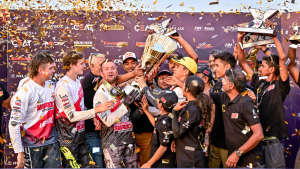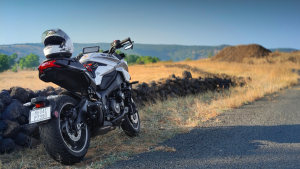Dakar 2017 preview: Everything you need to know about Sherco TVS' debut Dakar plans
People die on the Dakar. It seems a bit of a dark place to start this story, but it is vital that you understand how profoundly hard the world's most famous rally-raid really is. As Sherco boss Mark Teissier puts it, "There are many series where 15 one-day races complete the season. The Dakar is one 15-day race!"
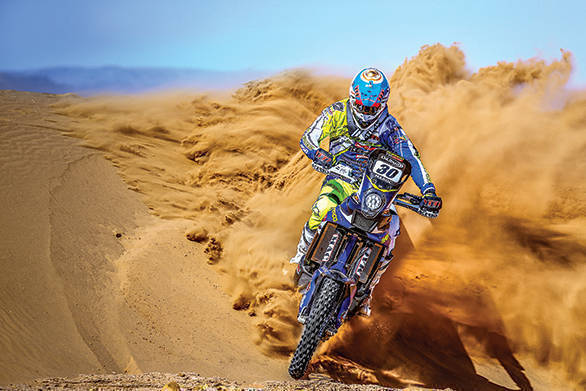
Talking to the riders as well as the team rapidly underlines the same theme again and again. Racing and rallying have always been about skill and speed. The Dakar adds many, many more dimensions to that. Mark's son Thomas says, "Anyone with some skill can get through the first week. After that..." He smiles and shakes his hands in the universal gesture that means too hot to handle, "...it's all in the mind."
The Dakar runs 9,000 hard hard hard kilometres. It is famous for its never-ending special stages as well as the need for the riders to navigate. A typical day starts at 3am. The riders will reach the end of the day after a hard day in the saddle many hundreds of kilometres later. They will brief their mechanics on any troubles they had which need to be looked at before heading to the rider's briefing for the next day between 8 and 9pm. Then a quick dinner and it's off to one of the three Sherco TVS vans to sleep five hours. That's a good, uneventful day.
The rest of the team hardly has it any easier. They will pack their set-up into the three Mercedes-Benz "pick-up" vans and drive hundreds of kilometres themselves to be ready for the riders to roll in in the evening. R Prakasam is responsible for Aravind KP's motorcycle. He says after Aravind briefs him, he will water-wash the bike down and inspect it end to end, looking for loose nuts and bolts and check the frame for cracks. Then he will check the engine oil - replace if necessary, and put in new oil- and air-filters. The tyres also last just one stage, so a new wheel-set will also be part of the agenda.
The trucks also include welding equipment should there be a need to fix anything broken. The engine is given a leak-down test on the rest day and a new engine is swapped in if needed. Similarly, Prakasam will also add new forks and monoshock on the rest day, halfway through the Dakar.
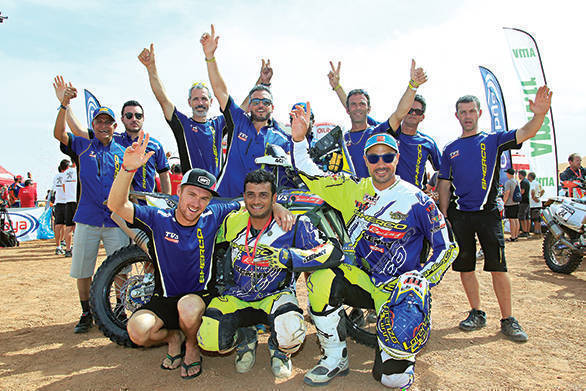 The Sherco TVS Factory Rally team is a lean operation. Nine people and three motorcycles will travel to Argentina to start the Dakar. David Casteau, a well-liked Dakar veteran, is the new Rally Raid Team manager and he is supported by a logistics chap who ensures that everything is in place for the team to function smoothly. Nine-time Dakar veteran Joan Pedrero is joined by Adrien Metge and Aravind KP as the teams' riders for the 2017 Dakar. Each will have a mechanic who will work with them right through the rally. TVS Racing's R Prakasam has been with the team for just under a year to learn the ropes. Prakasam will handle Aravind KP's motorcycle for the Dakar on his own. He has already demonstrated his ability by supporting Aravind at the OiLibya Morocco Rally and Baja Aragon campaigns with the team
The Sherco TVS Factory Rally team is a lean operation. Nine people and three motorcycles will travel to Argentina to start the Dakar. David Casteau, a well-liked Dakar veteran, is the new Rally Raid Team manager and he is supported by a logistics chap who ensures that everything is in place for the team to function smoothly. Nine-time Dakar veteran Joan Pedrero is joined by Adrien Metge and Aravind KP as the teams' riders for the 2017 Dakar. Each will have a mechanic who will work with them right through the rally. TVS Racing's R Prakasam has been with the team for just under a year to learn the ropes. Prakasam will handle Aravind KP's motorcycle for the Dakar on his own. He has already demonstrated his ability by supporting Aravind at the OiLibya Morocco Rally and Baja Aragon campaigns with the team
Thomas Teissier's point of the second week being hard has to do with this gruelling schedule adding mental and physical fatigue to the proceedings. This is why the second week of the Dakar is when the attrition rate reaches its usually epic proportions.
Team manager David Casteau is a Dakar veteran, and he says this is where strategy comes in. "On the rest day, we decide who of our riders is in the best position for a good finish. Then the other two riders will ride in support to help him finish as best as possible." This is a common strategy with all the teams who work towards maximising results as the rally wears on. Teissier adds, "It's easy to go too fast on the first few days. Many riders have shown speed and stage wins early in the Dakar." But the Dakar doesn't forgive those who cannot see the big picture. Aravind KP says, "The rally-raid requires a different mindset. You have to pace yourself and know when to push and when to conserve your strength." Indeed, Casteau adds, "If you're strong on sand but okay on gravel, you might choose to push on the dune stages but hold pace and stay out of trouble in the gravel stages."
But can the Dakar be won? Arun Siddarth, head of TVS motorcycles, says, "We came here to learn and we remain students. The team's goal for this year is to log a top-10 finish if they can and to definitely post a few stage wins along the way." The fact that Joan Pedrero, the impossibly lively Spaniard, won the Baja series for Sherco underlines their growing confidence and strength.
TVS is the first Indian manufacturer to head to the Dakar and this will be their third outing. Aravind KP will become the second Indian to take the Dakar start while Hero's CS Santosh will return to the Dakar on the Hero Speedbrain 450. Who will be the first Indian at the finish? Aravind smiles, "It's not personal but obviously I would be happy if I did."
Sherco TVS RTR 450
The basic motorcycle that underpins the Dakar machine is a Sherco 450 Enduro. But as you might expect of a machine intended to go the hardest 9,000km known to man today, it is quite a different beast by the time it is ready to take the start in Buenos Aires.
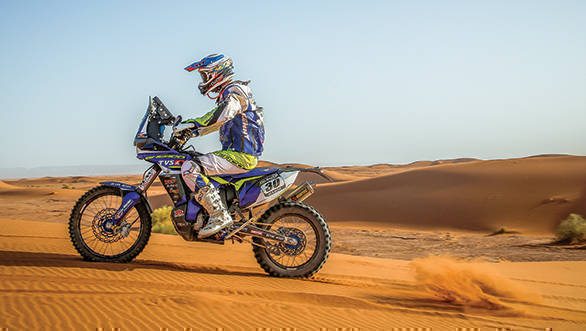
Suspension: The obvious changes are the suspension and set-up. The bikes run set-ups individual to the three riders and their weights and riding styles. But all have custom suspension with fully adjustable 52mm front forks by WP matched to fully adjustable rear monoshocks. The monoshock is mounted to a swingarm that is longer than stock. The extra length gives the motorcycle more stability and traction, which is crucial to the Dakar where there are long high-speed sections where the ability to go flat-out is crucial to race performance.
Frame: The rest of the frame is roughly stock. That means there are additional modifications to allow the mounting of equipment including crash and engine protection as well as the navigation tower and so forth. The frame is also strengthened in certain areas as demanded by the extreme nature of the Dakar.
Engine: The engine is a 450cc single as stipulated by the regulations and is more powerful for 2017. Sherco says it had to replace engines last year due to crank issues that have been fixed for this year. But evaluating the state of the engine on the rest day is part of routine maintenance, and an engine that seems past its best is usually replaced.
Wheels: The wheels aren't stock either. Thick, heavy-duty spokes are mounted to special rims and custom-made wheel hubs. Aravind KP says the set-up is designed to run 10,000km without trouble. The Michelin Rally tyres use a tube with nitrogen-filled foam, aka Bib Mousse, to prevent punctures during the Dakar. In that sense, as Michelin's sporting technical director Nicolas Goubert told us, the Dakar runs on airless tyres.
Fuel tanks: The fuel tanks are all over the motorcycle. No, really. The rear subframe hosts two carbon-fibre tanks that gravity feed into two front tanks mounted beside the cylinder head. Two fuel pumps (one for backup) send fuel up into the main tank from which the fuel-injection system draws petrol. The bikes are designed to run regular pump gas and the bikes carry between 32 and 38 litres of petrol. On the Dakar, Aravind says, fuel is available every 250-odd km.
Water tank: Ahead of and below the engine is a water tank that is required by Dakar rules. However, none of the riders actually ride with water in this tank. They prefer to have water worn as a hydration bladder for the ride.
Navigation tower: The final piece of the puzzle is the navigation tower. This includes a large road book, which is a scrolling tulip chart that occupies most of the space. Above this is a GPS Cap Repeater which tells the rider his heading. This is flanked by an odometer. Below the roadbook sits a speedometer that can be turned into an auxiliary odometer if the main one fails. Multiple buttons on the left switch set control the road book and the various displays. The entire tower assembly is mounted inside the fairing on an aluminium frame that mounts to the headstock. This weighs 8kg, approximately.
Sentinel system: The actual race trim we did not see this also adds a sentinel. This is a system that permits the Dakar control room to track and reach the rider. So if the rider stops for 5-10min, then it allows the control to call the rider and ask if s/he is ok. The system also warns the rider of approaching cars so that they can get out of the way.
Related Stories
Top Stories
Latest Videos
Most Popular
- Upcoming Mahindra XUV 3XO: All you need to know
- New Suzuki Swift spotted testing
- Budget Sportbike Showdown: Kawasaki Ninja 500 vs Aprilia RS 457 vs Yamaha YZF-R3
- Nissan Magnite EZ-Shift review - is the AMT any good?
- 2024 Hyundai Creta vs Toyota Urban Cruiser Hyryder vs Skoda Kushaq comparison review - the hype is real?
